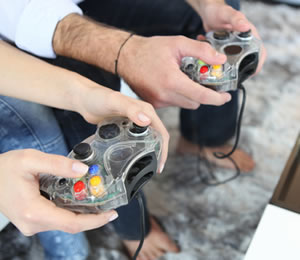Educators and game designers say gamification is not about adding games to classes, but designing classes as games
 Washington, D.C.– When video game designer and writer Lee Sheldon designed a physical fitness course called “Skeleton Chase,” he didn’t ask any students to climb into a sewer drain.
Washington, D.C.– When video game designer and writer Lee Sheldon designed a physical fitness course called “Skeleton Chase,” he didn’t ask any students to climb into a sewer drain.
Yet, one student, who saw it as the best means to attain his goal, did so, anyway. Sheldon showed a photograph of the student climbing into the tunnel to a small gathering of politicians, educators, and industry leaders Friday on Capitol Hill.
“If you get a student to do that,” he said, pointing to the photo, “you have engagement.”
Sheldon was one of a handful of game designers to speak about gaming in education as part of the launch of Excelsior College’s new Center for Game and Simulation-Based Learning. The new center is part of a larger shift on Excelsior’s part to establish itself as a research university. Earlier this year, the college opened its National Cybersecurity Institute.
Nearly 60 percent of Americans play video games, according to the Entertainment Software Association, with the average age of a gamer being 31. It’s not surprising then that a college like Excelsior, which primarily works with working adult students, would explore gaming in college education.
For the K-12 set, the ESA has also found that nearly 70 percent of parents of children who play video games believe that video games provide mental stimulation or education.
(Next page: Why Sheldon says digital badges are unnecessary)
At Friday’s event, Sheldon stressed that gaming in education does not mean simply adding video games into a classroom.
Sheldon, an associate professor at Rensselaer Polytechnic Institute, is renowned for his work in video games. He’s written and designed dozens of them, including “Star Trek: Infinite Space” and a series of games based on the mystery novels of Agatha Christie. He’s designed several computer games for college use, including a game that teaches students about engineering as they help an Irish family emigrate to Mars.
But in many of his own courses, the games are decidedly low-tech, making use of basic sets and actors in place of computer graphics.
“It’s not a game added to a class,” Sheldon said. “It’s a class designed as a game.”
But there’s one element of modern gaming moving into education that Sheldon doesn’t put much stock in: digital badges. The alternative form of accreditation has been growing in popularity in the last year or so, but Sheldon, who is also a prolific television writer, said he doesn’t believe students need external awards to be engaged.
Like a good movie or TV show, gaming itself should provide enough award.
“We don’t need no stinking badges,” Sheldon said.
Jesse Schell, CEO of Schell Games, said video games are built in a way that encourages that sort of full engagement.
People now love beautiful things to a degree they haven’t before, Schell said, pointing to the amount of colorful design options in an average toothbrush aisle. They love customization, he said, pointing to a website that allows you to put your own face on an M&M. They love sharing, he said, pointing to social media and Wikipedia.
And people love authenticity, he said. They like things to feel real.
“But is the classroom usually beautiful?” Schell asked. “No, it’s ugly. Is it customized? No, it’s standardized. Shared? No. ‘Eyes on your on paper, please.’ Is it real? No. Instead of an expert talking to a room full of interested people, it’s often someone in the front of the room pretending to be an expert, talking to a room full of students pretending to care.”
Games, he said, are designed with many of these attributes in mind, and are “good at giving the brain what it wants.”
And that’s becoming even more true now that touch screens are becoming so popular, he said. Originally computers operated through symbolic logic. Then, they operated through the use of tools — the mouse. But there is something that predates both of those concepts, and computers have finally reached back in time to harness that most innate ability, Schell said.
“Touch is primal,” he said, showing a video of a toad playing a game on an iPhone. “We’ve never had video games that animals could play intuitively, but we’ve now entered a world where that is possible.”
Sheldon said gaming, in its own way, is also primal.
“Games have been used since the beginning of time to teach,” he said. “Mammals learn to survive by playing games, and that includes humans, too.”
- What does higher-ed look like in 2023? - January 5, 2015
- Are ed-tech startups a bubble that’s ready to burst? - January 1, 2015
- Are MOOCs really dead? - August 28, 2014
